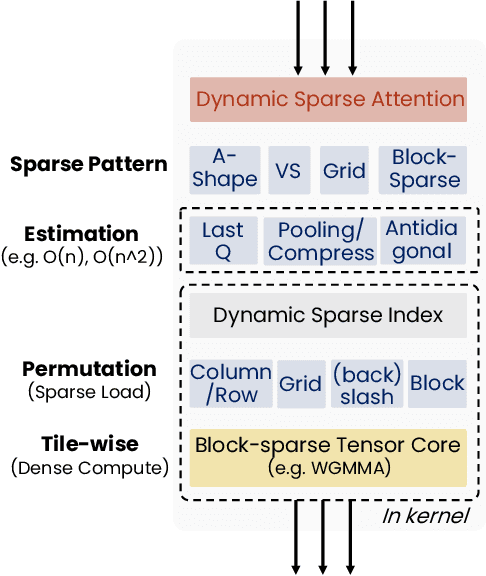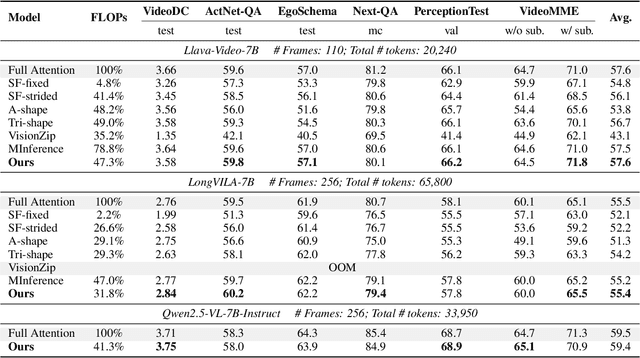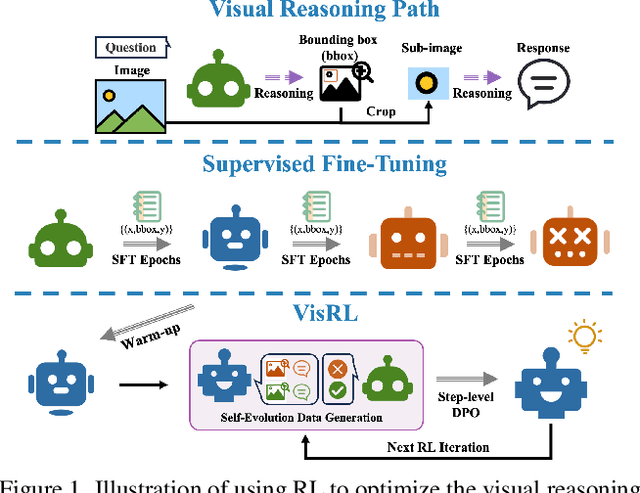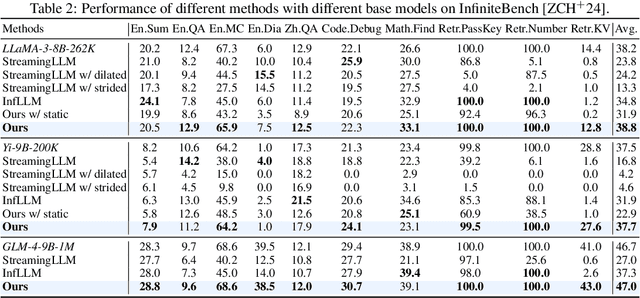Xufang Luo
$ΔL$ Normalization: Rethink Loss Aggregation in RLVR
Sep 09, 2025Abstract:We propose $\Delta L$ Normalization, a simple yet effective loss aggregation method tailored to the characteristic of dynamic generation lengths in Reinforcement Learning with Verifiable Rewards (RLVR). Recently, RLVR has demonstrated strong potential in improving the reasoning capabilities of large language models (LLMs), but a major challenge lies in the large variability of response lengths during training, which leads to high gradient variance and unstable optimization. Although previous methods such as GRPO, DAPO, and Dr. GRPO introduce different loss normalization terms to address this issue, they either produce biased estimates or still suffer from high gradient variance. By analyzing the effect of varying lengths on policy loss both theoretically and empirically, we reformulate the problem as finding a minimum-variance unbiased estimator. Our proposed $\Delta L$ Normalization not only provides an unbiased estimate of the true policy loss but also minimizes gradient variance in theory. Extensive experiments show that it consistently achieves superior results across different model sizes, maximum lengths, and tasks. Our code will be made public at https://github.com/zerolllin/Delta-L-Normalization.
Do Not Let Low-Probability Tokens Over-Dominate in RL for LLMs
May 19, 2025Abstract:Reinforcement learning (RL) has become a cornerstone for enhancing the reasoning capabilities of large language models (LLMs), with recent innovations such as Group Relative Policy Optimization (GRPO) demonstrating exceptional effectiveness. In this study, we identify a critical yet underexplored issue in RL training: low-probability tokens disproportionately influence model updates due to their large gradient magnitudes. This dominance hinders the effective learning of high-probability tokens, whose gradients are essential for LLMs' performance but are substantially suppressed. To mitigate this interference, we propose two novel methods: Advantage Reweighting and Low-Probability Token Isolation (Lopti), both of which effectively attenuate gradients from low-probability tokens while emphasizing parameter updates driven by high-probability tokens. Our approaches promote balanced updates across tokens with varying probabilities, thereby enhancing the efficiency of RL training. Experimental results demonstrate that they substantially improve the performance of GRPO-trained LLMs, achieving up to a 46.2% improvement in K&K Logic Puzzle reasoning tasks. Our implementation is available at https://github.com/zhyang2226/AR-Lopti.
Zoomer: Adaptive Image Focus Optimization for Black-box MLLM
Apr 30, 2025Abstract:Recent advancements in multimodal large language models (MLLMs) have broadened the scope of vision-language tasks, excelling in applications like image captioning and interactive question-answering. However, these models struggle with accurately processing visual data, particularly in tasks requiring precise object recognition and fine visual details. Stringent token limits often result in the omission of critical information, hampering performance. To address these limitations, we introduce \SysName, a novel visual prompting mechanism designed to enhance MLLM performance while preserving essential visual details within token limits. \SysName features three key innovations: a prompt-aware strategy that dynamically highlights relevant image regions, a spatial-preserving orchestration schema that maintains object integrity, and a budget-aware prompting method that balances global context with crucial visual details. Comprehensive evaluations across multiple datasets demonstrate that \SysName consistently outperforms baseline methods, achieving up to a $26.9\%$ improvement in accuracy while significantly reducing token consumption.
MMInference: Accelerating Pre-filling for Long-Context VLMs via Modality-Aware Permutation Sparse Attention
Apr 22, 2025



Abstract:The integration of long-context capabilities with visual understanding unlocks unprecedented potential for Vision Language Models (VLMs). However, the quadratic attention complexity during the pre-filling phase remains a significant obstacle to real-world deployment. To overcome this limitation, we introduce MMInference (Multimodality Million tokens Inference), a dynamic sparse attention method that accelerates the prefilling stage for long-context multi-modal inputs. First, our analysis reveals that the temporal and spatial locality of video input leads to a unique sparse pattern, the Grid pattern. Simultaneously, VLMs exhibit markedly different sparse distributions across different modalities. We introduce a permutation-based method to leverage the unique Grid pattern and handle modality boundary issues. By offline search the optimal sparse patterns for each head, MMInference constructs the sparse distribution dynamically based on the input. We also provide optimized GPU kernels for efficient sparse computations. Notably, MMInference integrates seamlessly into existing VLM pipelines without any model modifications or fine-tuning. Experiments on multi-modal benchmarks-including Video QA, Captioning, VisionNIAH, and Mixed-Modality NIAH-with state-of-the-art long-context VLMs (LongVila, LlavaVideo, VideoChat-Flash, Qwen2.5-VL) show that MMInference accelerates the pre-filling stage by up to 8.3x at 1M tokens while maintaining accuracy. Our code is available at https://aka.ms/MMInference.
VisRL: Intention-Driven Visual Perception via Reinforced Reasoning
Mar 10, 2025



Abstract:Visual understanding is inherently intention-driven - humans selectively focus on different regions of a scene based on their goals. Recent advances in large multimodal models (LMMs) enable flexible expression of such intentions through natural language, allowing queries to guide visual reasoning processes. Frameworks like Visual Chain-of-Thought have demonstrated the benefit of incorporating explicit reasoning steps, where the model predicts a focus region before answering a query. However, existing approaches rely heavily on supervised training with annotated intermediate bounding boxes, which severely limits scalability due to the combinatorial explosion of intention-region pairs. To overcome this limitation, we propose VisRL, the first framework that applies reinforcement learning (RL) to the problem of intention-driven visual perception. VisRL optimizes the entire visual reasoning process using only reward signals. By treating intermediate focus selection as a internal decision optimized through trial-and-error, our method eliminates the need for costly region annotations while aligning more closely with how humans learn to perceive the world. Extensive experiments across multiple benchmarks show that VisRL consistently outperforms strong baselines, demonstrating both its effectiveness and its strong generalization across different LMMs. Our code is available at this [URL](https://github.com/zhangquanchen/VisRL).
On Memory Construction and Retrieval for Personalized Conversational Agents
Feb 08, 2025Abstract:To deliver coherent and personalized experiences in long-term conversations, existing approaches typically perform retrieval augmented response generation by constructing memory banks from conversation history at either the turn-level, session-level, or through summarization techniques. In this paper, we present two key findings: (1) The granularity of memory unit matters: Turn-level, session-level, and summarization-based methods each exhibit limitations in both memory retrieval accuracy and the semantic quality of the retrieved content. (2) Prompt compression methods, such as \textit{LLMLingua-2}, can effectively serve as a denoising mechanism, enhancing memory retrieval accuracy across different granularities. Building on these insights, we propose SeCom, a method that constructs a memory bank with topical segments by introducing a conversation Segmentation model, while performing memory retrieval based on Compressed memory units. Experimental results show that SeCom outperforms turn-level, session-level, and several summarization-based methods on long-term conversation benchmarks such as LOCOMO and Long-MT-Bench+. Additionally, the proposed conversation segmentation method demonstrates superior performance on dialogue segmentation datasets such as DialSeg711, TIAGE, and SuperDialSeg.
SCBench: A KV Cache-Centric Analysis of Long-Context Methods
Dec 13, 2024



Abstract:Long-context LLMs have enabled numerous downstream applications but also introduced significant challenges related to computational and memory efficiency. To address these challenges, optimizations for long-context inference have been developed, centered around the KV cache. However, existing benchmarks often evaluate in single-request, neglecting the full lifecycle of the KV cache in real-world use. This oversight is particularly critical, as KV cache reuse has become widely adopted in LLMs inference frameworks, such as vLLM and SGLang, as well as by LLM providers, including OpenAI, Microsoft, Google, and Anthropic. To address this gap, we introduce SCBench(SharedContextBench), a comprehensive benchmark for evaluating long-context methods from a KV cachecentric perspective: 1) KV cache generation, 2) KV cache compression, 3) KV cache retrieval, 4) KV cache loading. Specifically, SCBench uses test examples with shared context, ranging 12 tasks with two shared context modes, covering four categories of long-context capabilities: string retrieval, semantic retrieval, global information, and multi-task. With it, we provide an extensive KV cache-centric analysis of eight categories long-context solutions, including Gated Linear RNNs, Mamba-Attention hybrids, and efficient methods such as sparse attention, KV cache dropping, quantization, retrieval, loading, and prompt compression. The evaluation is conducted on 8 long-context LLMs. Our findings show that sub-O(n) memory methods suffer in multi-turn scenarios, while sparse encoding with O(n) memory and sub-O(n^2) pre-filling computation perform robustly. Dynamic sparsity yields more expressive KV caches than static patterns, and layer-level sparsity in hybrid architectures reduces memory usage with strong performance. Additionally, we identify attention distribution shift issues in long-generation scenarios. https://aka.ms/SCBench.
LLM2CLIP: Powerful Language Model Unlocks Richer Visual Representation
Nov 26, 2024



Abstract:CLIP is a foundational multimodal model that aligns image and text features into a shared space using contrastive learning on large-scale image-text pairs. Its strength lies in leveraging natural language as a rich supervisory signal. With the rapid progress of large language models (LLMs), we explore their potential to further enhance CLIP's multimodal representation learning. This work introduces a fine-tuning approach that integrates LLMs with the pretrained CLIP visual encoder, leveraging LLMs' advanced text understanding and open-world knowledge to improve CLIP's ability to process long and complex captions. To address the challenge of LLMs' autoregressive nature, we propose a caption-to-caption contrastive learning framework to enhance the discriminative power of their outputs. Our method achieves substantial performance gains on various downstream tasks, demonstrating the effectiveness of combining LLMs with CLIP for enhanced multimodal learning.
LLM2CLIP: Powerful Language Model Unlock Richer Visual Representation
Nov 07, 2024



Abstract:CLIP is one of the most important multimodal foundational models today. What powers CLIP's capabilities? The rich supervision signals provided by natural language, the carrier of human knowledge, shape a powerful cross-modal representation space. However, with the rapid advancements in large language models LLMs like GPT-4 and LLaMA, the boundaries of language comprehension and generation are continually being pushed. This raises an intriguing question: can the capabilities of LLMs be harnessed to further improve multimodal representation learning? The potential benefits of incorporating LLMs into CLIP are clear. LLMs' strong textual understanding can fundamentally improve CLIP's ability to handle image captions, drastically enhancing its ability to process long and complex texts, a well-known limitation of vanilla CLIP. Moreover, LLMs are trained on a vast corpus of text, possessing open-world knowledge. This allows them to expand on caption information during training, increasing the efficiency of the learning process. In this paper, we propose LLM2CLIP, a novel approach that embraces the power of LLMs to unlock CLIP's potential. By fine-tuning the LLM in the caption space with contrastive learning, we extract its textual capabilities into the output embeddings, significantly improving the output layer's textual discriminability. We then design an efficient training process where the fine-tuned LLM acts as a powerful teacher for CLIP's visual encoder. Thanks to the LLM's presence, we can now incorporate longer and more complex captions without being restricted by vanilla CLIP's text encoder's context window and ability limitations. Our experiments demonstrate that this approach brings substantial improvements in cross-modal tasks.
MInference 1.0: Accelerating Pre-filling for Long-Context LLMs via Dynamic Sparse Attention
Jul 02, 2024



Abstract:The computational challenges of Large Language Model (LLM) inference remain a significant barrier to their widespread deployment, especially as prompt lengths continue to increase. Due to the quadratic complexity of the attention computation, it takes 30 minutes for an 8B LLM to process a prompt of 1M tokens (i.e., the pre-filling stage) on a single A100 GPU. Existing methods for speeding up prefilling often fail to maintain acceptable accuracy or efficiency when applied to long-context LLMs. To address this gap, we introduce MInference (Milliontokens Inference), a sparse calculation method designed to accelerate pre-filling of long-sequence processing. Specifically, we identify three unique patterns in long-context attention matrices-the A-shape, Vertical-Slash, and Block-Sparsethat can be leveraged for efficient sparse computation on GPUs. We determine the optimal pattern for each attention head offline and dynamically build sparse indices based on the assigned pattern during inference. With the pattern and sparse indices, we perform efficient sparse attention calculations via our optimized GPU kernels to significantly reduce the latency in the pre-filling stage of long-context LLMs. Our proposed technique can be directly applied to existing LLMs without any modifications to the pre-training setup or additional fine-tuning. By evaluating on a wide range of downstream tasks, including InfiniteBench, RULER, PG-19, and Needle In A Haystack, and models including LLaMA-3-1M, GLM4-1M, Yi-200K, Phi-3-128K, and Qwen2-128K, we demonstrate that MInference effectively reduces inference latency by up to 10x for pre-filling on an A100, while maintaining accuracy. Our code is available at https://aka.ms/MInference.
 Add to Chrome
Add to Chrome Add to Firefox
Add to Firefox Add to Edge
Add to Edge